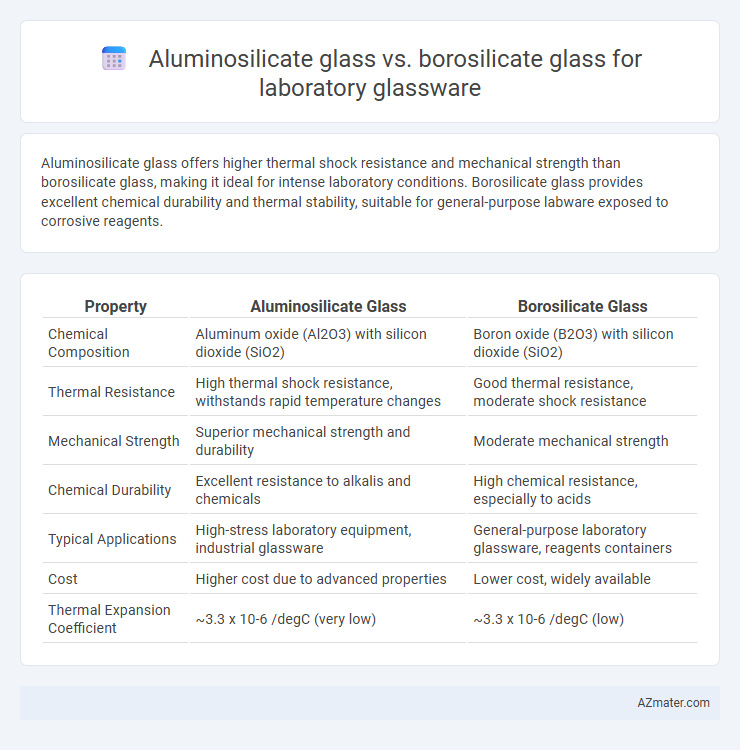Aluminosilicate glass offers higher thermal shock resistance and mechanical strength than borosilicate glass, making it ideal for intense laboratory conditions. Borosilicate glass provides excellent chemical durability and thermal stability, suitable for general-purpose labware exposed to corrosive reagents.
Table of Comparison
| Property | Aluminosilicate Glass | Borosilicate Glass |
|---|---|---|
| Chemical Composition | Aluminum oxide (Al2O3) with silicon dioxide (SiO2) | Boron oxide (B2O3) with silicon dioxide (SiO2) |
| Thermal Resistance | High thermal shock resistance, withstands rapid temperature changes | Good thermal resistance, moderate shock resistance |
| Mechanical Strength | Superior mechanical strength and durability | Moderate mechanical strength |
| Chemical Durability | Excellent resistance to alkalis and chemicals | High chemical resistance, especially to acids |
| Typical Applications | High-stress laboratory equipment, industrial glassware | General-purpose laboratory glassware, reagents containers |
| Cost | Higher cost due to advanced properties | Lower cost, widely available |
| Thermal Expansion Coefficient | ~3.3 x 10-6 /degC (very low) | ~3.3 x 10-6 /degC (low) |
Introduction to Laboratory Glassware Materials
Aluminosilicate glass offers superior chemical resistance and higher thermal stability compared to borosilicate glass, making it ideal for aggressive laboratory applications involving strong acids and alkalis. Borosilicate glass remains widely used in laboratory glassware due to its excellent thermal shock resistance and affordability, suitable for general-purpose heating and cooling processes. The choice between aluminosilicate and borosilicate glass depends on specific experimental conditions, with aluminosilicate favored for high durability and borosilicate for versatile everyday use.
Overview of Aluminosilicate Glass
Aluminosilicate glass is a highly durable material renowned for its exceptional thermal and mechanical resistance, making it ideal for laboratory glassware subjected to extreme conditions. It offers superior chemical resistance compared to borosilicate glass, particularly against alkalis and acids, enhancing its longevity and reliability in aggressive chemical environments. This glass type also features a higher melting point and greater impact resistance, providing enhanced performance in demanding scientific applications.
Overview of Borosilicate Glass
Borosilicate glass is a type of laboratory glassware known for its exceptional thermal resistance, chemical durability, and low thermal expansion coefficient, making it ideal for high-temperature applications and chemical reactions. It primarily consists of silica and boron trioxide, which contribute to its resistance against thermal shock and corrosion from acidic and alkaline substances. Widely used in scientific labs, borosilicate glass offers superior mechanical strength and clarity compared to aluminosilicate glass, making it a preferred choice for precision instruments and reliable experimental results.
Chemical Resistance: Aluminosilicate vs Borosilicate
Aluminosilicate glass exhibits superior chemical resistance compared to borosilicate glass, particularly against alkalis and acids, making it ideal for highly reactive laboratory chemicals. Borosilicate glass offers good resistance to thermal shock and moderate chemical exposure but is more susceptible to attack by strong alkaline solutions. Laboratories handling aggressive reagents prefer aluminosilicate for its enhanced durability and long-term stability in harsh chemical environments.
Thermal Stability and Expansion
Aluminosilicate glass exhibits superior thermal stability with a high softening point around 1750degC and a low coefficient of thermal expansion (CTE) approximately 3.3 x 10^-6 /degC, making it ideal for high-temperature laboratory applications requiring rapid temperature changes. Borosilicate glass has a moderate softening point near 820degC and a slightly higher CTE of about 3.3 x 10^-6 to 4.0 x 10^-6 /degC, providing good thermal shock resistance and chemical durability for general lab use. The enhanced thermal stability and lower expansion of aluminosilicate glass reduce stress and cracking risks under extreme heating and cooling cycles compared to borosilicate glass.
Mechanical Strength and Durability
Aluminosilicate glass offers superior mechanical strength compared to borosilicate glass, making it ideal for applications requiring high resistance to impact and thermal shock. Its enhanced durability supports repeated sterilization and heavy-use conditions in laboratory settings. Borosilicate glass, while thermally resistant, is more prone to fracturing under mechanical stress than aluminosilicate alternatives.
Cost and Availability Comparison
Aluminosilicate glass generally offers higher thermal shock resistance and mechanical strength but comes at a significantly higher cost and lower availability compared to borosilicate glass, which remains the industry standard for laboratory glassware due to its relatively low price and widespread distribution. Borosilicate glass is favored for routine lab applications because it combines sufficient chemical durability with broad supplier access, making it economically practical for large-scale use. Labs requiring enhanced durability may invest in aluminosilicate glass despite its premium pricing and more limited supply.
Typical Laboratory Applications
Aluminosilicate glass is preferred for laboratory applications requiring high thermal shock resistance and mechanical strength, such as in high-temperature furnaces and chemical reactors. Borosilicate glass is widely used for its excellent chemical durability and low thermal expansion, making it ideal for general-purpose laboratory glassware like beakers, flasks, and pipettes. Both types are chosen based on specific experimental conditions, with aluminosilicate excelling in high-stress environments and borosilicate suited for routine chemical handling and heating tasks.
Safety Considerations and Breakage Risks
Aluminosilicate glass offers superior thermal shock resistance and higher mechanical strength compared to borosilicate glass, making it less prone to breakage under rapid temperature changes in laboratory settings. Borosilicate glass, while chemically resistant, has a lower tensile strength resulting in increased risks of cracking or shattering when subjected to thermal or mechanical stress. Safety considerations prioritize aluminosilicate glass in high-stress experiments due to its enhanced durability and reduced risk of hazardous breakage incidents.
Choosing the Right Glass for Your Laboratory Needs
Aluminosilicate glass offers superior thermal shock resistance and higher mechanical strength compared to borosilicate glass, making it ideal for high-stress laboratory applications. Borosilicate glass is favored for its excellent chemical resistance and affordability, suitable for routine chemical handling and heating. Selecting the right glass depends on balancing temperature tolerance, chemical compatibility, and budget constraints in your laboratory processes.

Infographic: Aluminosilicate glass vs Borosilicate glass for Laboratory glassware
 azmater.com
azmater.com